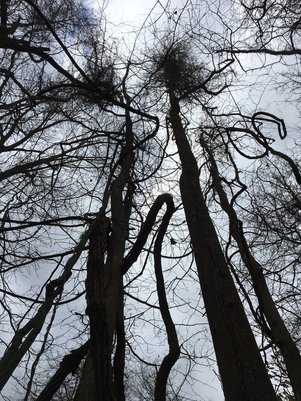 During winter it’s easy to see the damage vines inflict on trees as they stretch up and out over the tree’s canopy. (Picture curtesy of Fyrne Lake) During winter it’s easy to see the damage vines inflict on trees as they stretch up and out over the tree’s canopy. (Picture curtesy of Fyrne Lake) Too many vines and not enough time. Vines literally covered parts of our farm when we purchased it. Well, they still do in some areas. Kudzu was the main culprit. But there are several others that pose a danger to the trees of my precious forest. Yes, I said precious. Please don’t laugh or call me a tree hugger (that term has other connotations). But, you can call me obsessed. I truly love my woods and am driven to protect and defend it. Most vines are my enemy. I’ve written before about my fight with kudzu. Wherever it starts soon becomes nothing else. It’s like a cancer that climbs and smothers trees until they die and eventually fall. In the June/July 2012 issue of this magazine I shared my battle with this invasive species (also posted on my blog @ www.fyrnelake.com). This article is the first of a series that will share with you my experience with other damaging, and in some cases threating, vines. How can a vine be threating you ask? Have you ever gotten poison ivy? If you have, you know what I mean! Except for the few lucky immune individuals, the oil of the poison ivy plan is an extreme irritant. This oil is called urushiol and is also found in poison oak and poison sumac. This oil is found on and in ALL parts of these plants, even their roots. According to The American Academy of Dermatology, 85% of us are allergic. I wish I was one of the lucky ones that wasn’t. For some reason I had avoided a reaction to poison ivy most of my life. So I wasn’t that worried about it on my first solo weekend camping trip on the farm. It was within the first few months after we had purchased the property. I was excited! Most of the farm was an unexplored wilderness to me. I was more than anxious to get started and I was prepared for the adventure! I had an aerial photograph to guide me, compass to keep me on course, camping gear for comfort, and a camera to record the adventure! The property was massive and covered with intersecting wooded gullies, meandering ridge fields and a central mile long lake. It was early summer and the foliage was thick! I chose to start walking along a ridge field looking for an easy entrance through the thick briars and into the woods. Often I would see vines climbing up the trees above the briar wall. In some cases these vines were covering the trees much like kudzu will, however, it wasn’t kudzu. I eventually decided to just push through the barrier into the woods. Much to my relief, the undergrowth opened up under the tree canopy. It was breath taking! I absolutely loved it. I felt alive and excited about exploring more! I began descending the aggressive slope of the first gully, hanging on to one tree after another to steady my footing. Once I reached the bottom I had a choice, follow the gully or ascend the other side. I looked at my compass, I had a destination in mind on this hike… to find the farm’s northern boundary. To do that I needed to climb. When I made it to the top it was time to descend again. I grabbed a tree and headed down into the next gully. Each successive gully had its own secrets to reveal. I discovered majestic oaks, expansive bottomland covered in horsetail, 100 foot tall cottonwoods, hints of old logging roads, exposed veins of gravel and oozing mineral springs. Eventually my search paid off. I found traces of a barbed wire fence running east and west. This must be it! I changed directions and headed west trying my best to follow what wire I could find. It was now getting late and I needed to make my way back to camp before I lost whatever sunlight was left. By then, the hill climbing was getting to me and I found myself taking more rest breaks. While catching my breath, I scanned the forest and began noticing random vines climbing trees. Many of the vines were 2-3 inches in diameter while a few reached 8 inches or more! Looking up, I observed how once these vines reached the tree canopy, they stretched out over the tree branches blocking out much of the light. As I walked, I came across breaks in the canopy were vine covered trees had fallen, taking the vines with them. These vines were killing the forest! I knew that kudzu could quickly cover and kill a tree, but these vines were doing the same, although much slower. But why? Unlike kudzu, these wild vines were native to west Tennessee. Why were they taking over like an invasive? I intended to find out why and what I could do to defend my new sanctuary, this beautiful forest! I finally made it back to camp, built a fire, grilled a couple hotdogs on a stick and then reflected on the day’s adventures while drifting off in my sleeping bag. The next morning I was in for a surprise! I awoke with an itch that seemed to be spreading. Soon a rash appeared… I had poison ivy!!! And it wasn’t just in a few places, it was spreading everywhere! On my arms, neck and face… on my legs, feet and back. Before I made it home it had spread to my scalp. It was horrible! I couldn’t have gotten it on more areas of my body than if I’d tried! It was like I had taken off all my clothes and rolled around on it. The meds I found at the drug store for treatments at most helped with the itching, but it was getting worse. So, I broke down and visited my doctor. He put me on steroids which, with time, took the fire out and faded away the rash. But, now I was worried. I just took out a huge mortgage to purchase my dream property and I was allergic to it! I had to find out what happened and how I could prevent it in the future. I retraced my steps from the day before. Had there been poison ivy vines on the trees I used as support on the slopes? Did I take a rest break or two in a patch of ground ivy? I definitely touched it somewhere… but not with every part of my body! After talking over the day with my father, he came up with a theory. The first question he asked me was, did I wash up once I returned to camp? No, I had not. I was camping. The little water I had I was saving to drink. THAT, he said, was the beginning of my problem. He explain how poison ivy’s urushiol oil can easily get on you by simply brushing up against it. If you break or cut a vine the oil will spray out toward you. The oil doesn’t even need to touch your skin. It will stick to your clothes. OH NO! MY CLOTHES! I had slept in my clothes! I had gotten into my sleeping bag fully clothed and removed my pants and shirt after I warmed up. By the time they were off the oil had spread throughout the bag. No wonder I had poison ivy everywhere. I was determined NEVER to let this happen again! Were there other ways I could get it? How much time did I have to wash the oil off before it was too late? And, what was the best way to remove this allergen from my skin?
The reality is there are several ways to get poison ivy without directly touching it. I discovered that besides getting the oil from yours or someone else’s clothing, touching a used garden tool, weed eater or lawnmower that has cut poison ivy, oak or sumac can transfer it to your skin. Even a pet or trail bike can pick up the oil. My wife loves her dogs and has often gotten poison ivy on the inside of her wrists from greeting one particular dog as he returns from running free in the woods. However the worst way to be exposed is through fire! Burning a log with poison ivy vines attached, no matter how dead they look, will add their oil to the smoke. Inhaling this smoke can cause a severe reaction that will require seeing a physician, maybe even a trip to the emergency room! The Mayo Clinic says that the urushiol oil will begin bonding with the skin within 30 minutes. A commercially available ivy wash recommends washing your skin vigorously for two minutes within 2-8 hours after exposure and rinse with cool water. Obviously, the sooner you can wash after being out in the woods the better. While I was doing my research, an image from my childhood kept creeping into my mind. I have to admit, it was a little traumatic. We were visiting my grandparent’s farm in Indiana and my brother and I were waiting in the car while my father and a couple of his friends were in the woods hunting mushrooms. When they emerged my father immediately started stripping down to his underwear and made a bee line for a nearby stream. There he began smearing his body from head to toe with mud! My father wasn’t known for being shy, but this even took his friends (and me) by surprise. Noticing their stares he explained that the woods had been full of poison ivy and it was impossible to avoid it while gathering the mushrooms. The mud, he said, would wash off the poison ivy oil. This country remedy apparently worked. He never got poison ivy. Now, 40 years later, I’ve recovered from that childhood experience and was ready to see if a mud bath might help me overcome my current challenge, dealing with poison ivy! I’ve come to find that a lot of country remedies square with science and this just might be one of them. The commercial wash mentioned above is a suspension, meaning it requires shaking to mix up the small particles it contains before use. This product was very much like a thin light colored mud my father used. Hmm… This commercial product stated that it bonds with the oil and helps to lift it off the skin so it can be washed away by cool water. The cool water is preferred to warm because warmer temperatures would thin the oil and spread it out exposing more of your skin. The stream my father used to wash the mud off was obviously cool, maybe even cold (I remember him shivering). Maybe the slightly abrasive mud combined with cool stream water is just as good as or even better than the store bought remedy! Well… It was worth a try! The next chance I had I used mud. Even today, I use mud when I don’t think I’ll have enough time to wait for a shower. So, do you want to know if I ever stripped down for a mud bath??? The answer is yes! However, most of the time I’d simply take off my shirt and smear my arm, neck and face. I have to admit, it worked every time! What has kept me from having to take mud baths very often is wearing (and washing after use) the proper protective clothing while in the woods. No matter how hot it gets, I always wear boots, jeans, gloves, wide brim hat and an unbuttoned long sleeve shirt over a T-shirt. This provides a barrier for my skin from ivy oil exposure while also shielding me from most insects and briars. Poison ivy vines are a nuisance to humans. But with proper preparation, caution and care severe reactions can be avoided. The good news is poison ivy poses hardly any threat to my precious trees. Their vines simply use their trunks and branches for support and typically stay beneath its leaf canopy making it harmless to the forest. Other vines pose a greater threat. In my next article I’ll explain this threat, why it’s worse now than a generation ago and what I’m doing to fight it. Until then, try not to think about seeing YOUR father stripped down in a mud bath! Comments are closed.
|
AuthorKevin Griffith Archives
September 2018
Categories |
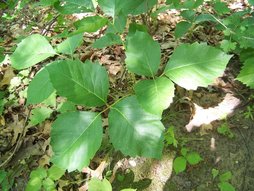
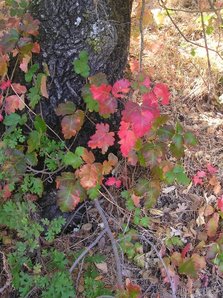
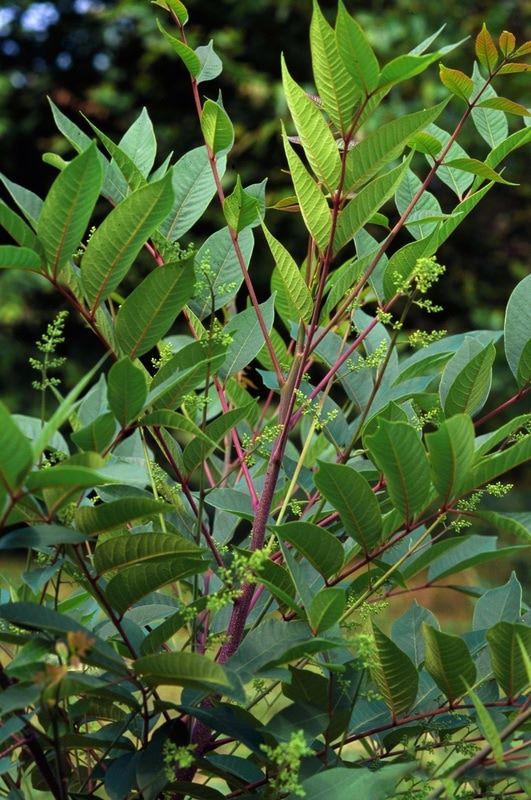
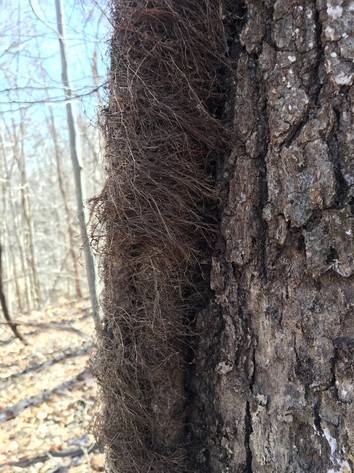
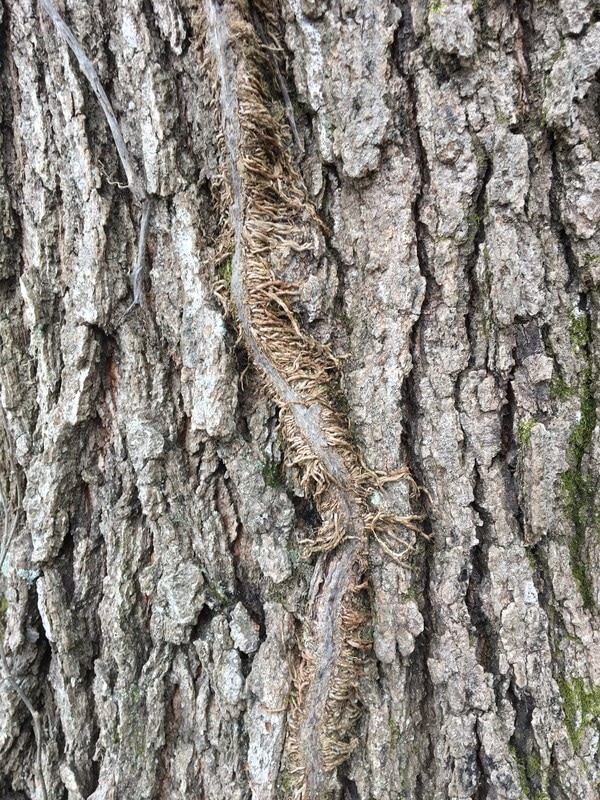
 RSS Feed
RSS Feed